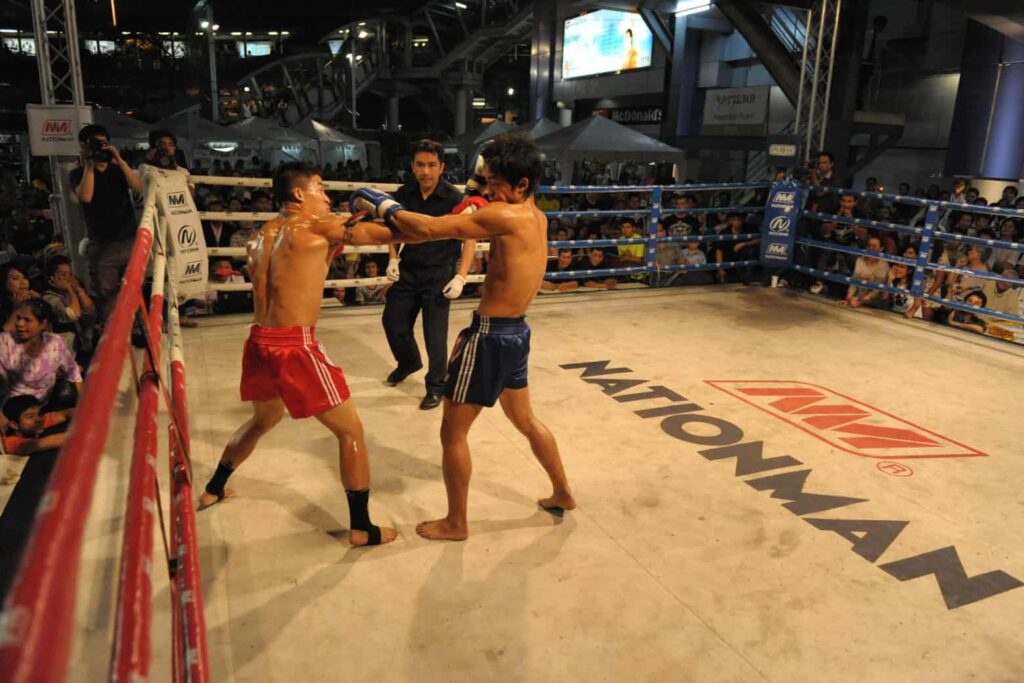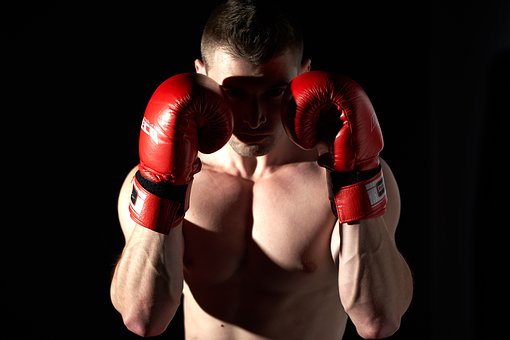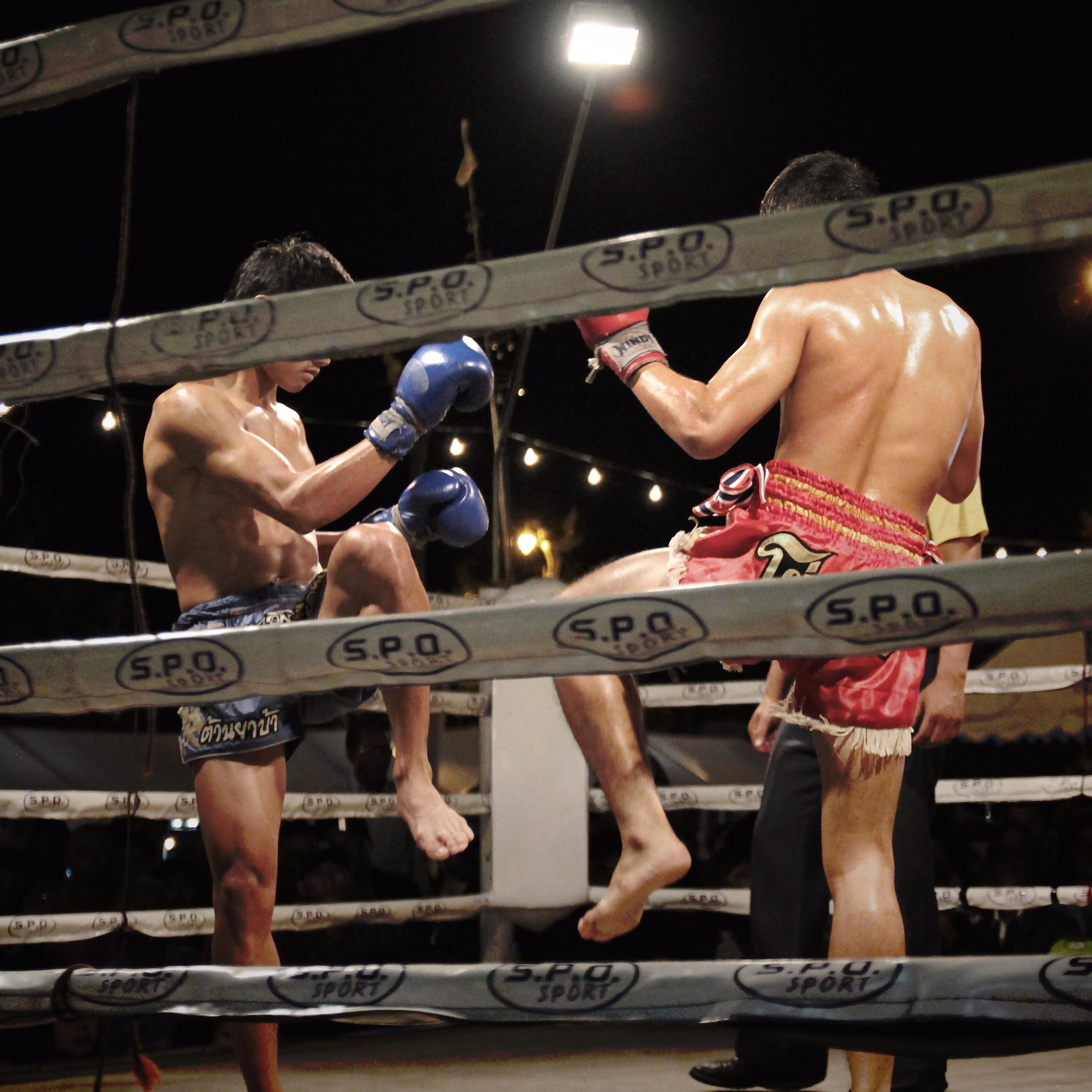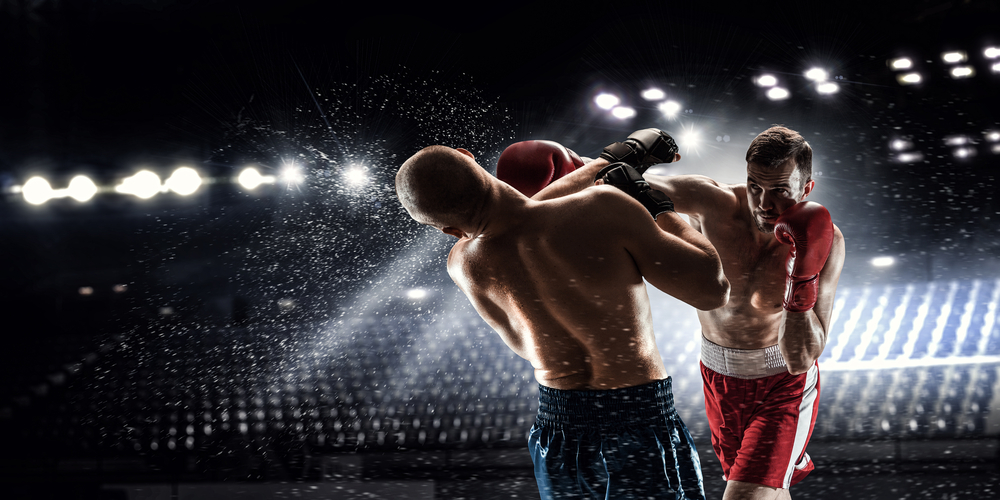Western boxing is a major part of muay thai in terms of technique and also in terms of the history of the development of modern day rules and styles of muay thai.
In this post we look at:
- how Western boxing influenced modern Thai boxing
- main differences between muay thai and boxing
- the Muay Mat style which is centered around boxing punches
- Cross-over muay thai/boxing champions
History of Western Style and Thai Boxing
Boxing has played a major role in shaping muay thai as the competitive sport we know today.
Prior to standardizing the use of gloves and protective gear, fight shorts, the use of a ring and judges and timed rounds, muay thai was more traditional.
This more traditional style, prior to boxing influence to make it a competitive ring sport, was called muay boran or ancient boxing.
Traditional ‘boran’ fights used kard cheuk or rope wraps, without time limits or judges and usually took place at traditional celebration events. They were fought until one fighter was knocked out or gave up.

Modern day muay thai as we recognize it around the world today, began in the 1920s with the introduction of boxing style rounds and the ring and establishment of rules including 5 timed rounds and the use of groin protection, mouth guards and gloves.
Over time dedicated stadiums were built around Thailand and gambling also became more and more influential.
So from the birth of modern muay thai, boxing has played a major role in the development of the sport to what we see today.
The influence of boxing is evident in the rules, regulations, judges, scoring and timed rounds which did not exist before the 1920s.
Differences Between Boxing & Muay Thai
Pretty much all of the weapons used in boxing are used in muay thai as well, of course with the addition of knees, elbows and kicks. The first of weapons a young muay thai boxer would learn would probably be the Jab closely followed by the rear hand.
With the addition of knees, kicks and elbows, muay thai has taken traditional boxing techniques and adjusted them to be more suited for the Thai style.
Differences in Stance
The stance in muay thai is quite different from boxing as stance is more upright than in Western style which tends to be in a more lowered and grounded athletic stance.
The feet are wider in Thai style also and more square to the opponent as opposed to the ‘bladed’ Western style stance which prefers a side on stance so as to make a smaller target for the opponent to hit.
In Thai the elbows are more open or flared out in comparison to Western style where the elbows are kept closer to the body for protection against body shots.

As a result of major differences in stance, the punches in the Thai boxing style also tend to be thrown differently from Western style.
Long vs Short Compact Punches
Punches in Thai style boxing tend to be more of a mid to longer range weapon than in Western style boxing.
Western style boxing favors short powerful and compact punches especially in the close range distance.
In muay thai however the close range tends to be reserved for clinching, elbows and knees.
Though short sharp compact punches are also definitely used in muay thai.
But overall the punches in muay thai tend to be longer with closer range techniques more focused on clinching, elbos and knees.
Hooks in Muay Thai
A great example of a typical Western style technique adjusted for muay thai is the hook.
In boxing it is taught that one should pivot the foot of the hooking arm in order to get momentum and power.
In muay thai this is not encouraged as much as pivoting the foot can make it more difficult to fire off a kick from the opposite leg of the hook.
Therefore muay thai hooks are often thrown without pivoting.
Head Movement
Head movement is key in boxing.
Slipping and rolling are major components of boxing defense and counter tactics.
In muay thai however, head movement is not encouraged as much.
This is likely because lowering the head off angle can make on vulnerable to knees and kicks to the face.
However, this is not to say head movement does not exist in muay thai.
Muay thai legends such as Somrak and Samart displayed excellent head movement in their muay thai which allowed evasion and counter attack in a beautiful manner.
Muay Mat Style in Muay Thai
The muay mat style came out of the use of heavy punch combos combined with hard low kicks.
The muay mat style uses a forward marching to engage with punches style to keep pressure on with multiple punch combos and heavy low kicks to wear the opponent down.
The style of muay mat is a popular style for spectators especially when matched against another style of muay thai such as femur or khao.

A muay mat fighter possess skillful and powerful boxing and prefers to end the fight with the hands through constant pressure on the opponent.
Great Thai fighters who displayed the muay mat style include:
- Sagat Petchyindee
- Samson Isaan
- Anuwat Kaewsamrit
- Rodtang Jitmuangnon
Thai & Western Style Champions
Some of the best muay thai fighters have also displayed exceptional skills in the boxing ring.
Not just limited to muay mat style fighters, nak muay who have achieved success in boxing also are of the femur style such as Somarak and Samart.
But typical powerful punching muay mat stylists also made successful transitions to boxing and gained world titles such as Veerapol
Somrak Khamsing
One of the most heralded and popular muay thai fighters is Somrak Khamsing.
He was known as a dominant femur style fighter.
Although never establishing himself as a stadium Champion, Somrak took up amateur boxing and became Olympic Boxing Champion and gold medalist in 1996, the same Olympics that Floyd Mayweather won Bronze at.
Samart Payakaroon
One of the greatest muay thai fighters of all time. Samart was also a dominant femur style fighter.
He had legendary style vs style matches with the legendary Dieselnoi and his clinch and knee muay khao style.
Samart became the WBC Super Bantam Weight Champion in 1986.
Saenchai
Saenchai is an active muay thai fighters who as of Decemmber 2020 has amassed 57 straight victories in muay thai.
He will go down as one of the greatest of all time.
Nearing the end of his career, Saenchai also achieved the Pan Asia Boxing Association Championship in 2002.
Saensak Muangsurin
Saensak was a muay mat style Thai fighter who won the 140lb Lumpinee title and was awarded Sports Writers Fighter of the Year in 1973.
Saensak still holds the boxing record of winning a world title in the only three fights in 1975.
This record is tied with Vasyl Lomachecnko who achieved a title in three fights in 2014.
Veerapol Sahaprom
Veerapol Sahaprom is a well known muay mat style fighter who was also a 3-time Rajademnern champion.
He transitioned to boxing in 1994 where he became WBA and WBC Bantamweight word champion.
Veerapol defended his WBC belt 14 times in his incredible world championship reign.
Wrap Up
Boxing has had major impact on the development of modern day muay thai that we see in the ring in stadiums all around the world today.
Beyond rules and regulations, boxing has also influenced style, technique and tactics within muay thai.
Muay thai has taken the fundamentals of boxing and capitalized on their strengths to make use of them in the muay thai ring.
The muay mat style is one of the most popular among spectators, and rightfully so as a high pressure style from start to finish always looking to hurt the opponent and get the KO.
Many great thai fighters have also had great success in the Western boxing ring and this shows the influence of boxing in muay thai which began back in the 1920s.



